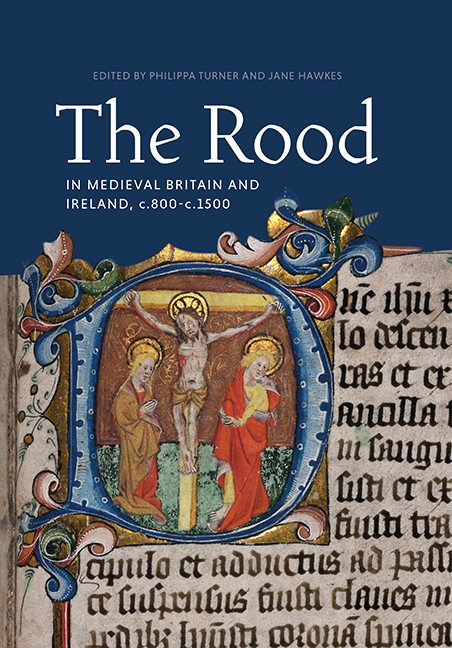Book contents
- Frontmatter
- Contents
- List of Illustrations
- List of Contributors
- Acknowledgements
- List of Abbreviations
- 1 Introduction: Rethinking the Rood
- 2 Approaching the Cross: The Sculpted High Crosses of Anglo-Saxon England
- 3 The Mark of Christ in Wood, Grass and Field: Open-Air Roods in Old English Medical Remedies
- 4 Twelfth-Century English Rood Visions: Some Iconographic Notes
- 5 Crosses, Croziers and the Crucifixion: Twelfth-Century Crosses in Ireland
- 6 From Religious Artefacts to Symbols of Identity: The Role of Stone Crosses in Galician National Discourse
- 7 The Rood in the Late Medieval English Cathedral: The Black Rood of Scotland Reassessed
- 8 The Cross of Death and the Tree of Life: Franciscan Ideologies in Late Medieval Ireland
- 9 Heralding the Rood: Colour Convention and Material Hierarchies on Late Medieval English Rood Screens
- 10 Reframing the Rood: Fifteenth-Century Angel Roofs and the Rood in East Anglia
- Bibliography
- Index
- Already Published
- Plate Section
9 - Heralding the Rood: Colour Convention and Material Hierarchies on Late Medieval English Rood Screens
Published online by Cambridge University Press: 07 November 2020
- Frontmatter
- Contents
- List of Illustrations
- List of Contributors
- Acknowledgements
- List of Abbreviations
- 1 Introduction: Rethinking the Rood
- 2 Approaching the Cross: The Sculpted High Crosses of Anglo-Saxon England
- 3 The Mark of Christ in Wood, Grass and Field: Open-Air Roods in Old English Medical Remedies
- 4 Twelfth-Century English Rood Visions: Some Iconographic Notes
- 5 Crosses, Croziers and the Crucifixion: Twelfth-Century Crosses in Ireland
- 6 From Religious Artefacts to Symbols of Identity: The Role of Stone Crosses in Galician National Discourse
- 7 The Rood in the Late Medieval English Cathedral: The Black Rood of Scotland Reassessed
- 8 The Cross of Death and the Tree of Life: Franciscan Ideologies in Late Medieval Ireland
- 9 Heralding the Rood: Colour Convention and Material Hierarchies on Late Medieval English Rood Screens
- 10 Reframing the Rood: Fifteenth-Century Angel Roofs and the Rood in East Anglia
- Bibliography
- Index
- Already Published
- Plate Section
Summary
Late medieval English church roods are mostly known by their near-total loss, their fragmentary remains, and by the still-painted spaces that frame their absence. One of the most well-known examples is the ghosted raguly tree-of-life cross outline on Suffolk's Wenhaston Doom tympanum. The mixed-media nature of the decorative apparatus which surrounded and augmented the rood is demonstrated by empty outlines of roods in numerous chancel arch wall paintings, the blank space the lacuna where polychrome three-dimensional roods once stood over wooden structures combining rich carvings, two-dimensional paintings, glass, tin-relief, gilded surfaces, as well as the squint holes cut by devout parishioners keen to see the elevation of the host at Mass.
Nevertheless, despite the loss of nigh-on every late medieval English rood, much about the main crucifix of the church can be gleaned from what still survives. It is commonly accepted, and evident from the proliferation of rood loft stairs, that by the mid-fifteenth century, virtually every church in England had a chancel screen, sometimes of stone and sometimes of wood, depending on the region, intrinsically linked to the presentation of the rood. The screens discussed here largely date from about 1420‒1536 and centre on East Anglia and the West Country as a substantial number of screens in these two regions retain enough polychromy to perceive decorative choices as well as structural designs. By the mid-fifteenth century, the heyday of the English screen, the ensemble tended to consist of a solid lower dado, about a metre and a half in height and crossed by a transom, above which rose the decorative lights, filled with tracery at the top. Some screens had doors, and this is more commonly the case in Devon than East Anglia. Usually the screen was galleried with a rood loft and topped by the rood, and figures of Mary and John the Evangelist, and perhaps the good and bad thieves or attendant angels. The rood group was sometimes placed on a rood beam but could also be part of the parapet of the rood loft. It was often backed by a painted tympanum and/or decorated chancel arch, usually depicting the Doom.
- Type
- Chapter
- Information
- The Rood in Medieval Britain and Ireland, c.800-c.1500 , pp. 145 - 160Publisher: Boydell & BrewerPrint publication year: 2020



